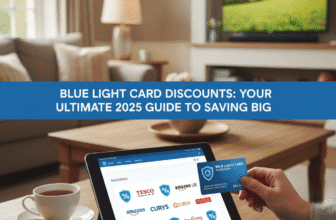
The Secret Sale Bible: Your Ultimate Guide to Unlocking Hidden Discounts in the UK
We’ve all been there. You’ve just bought that new coat, a fancy coffee machine, or booked a weekend getaway, only for your mate to pipe up down the pub, “Oh, you bought that? I got it for 30% off last week in their secret sale.” The feeling is a unique cocktail of frustration, envy, and a grudging respect for their savvy shopping skills. What is this clandestine world of ‘secret sales’? Is it some exclusive club with a secret handshake and a velvet rope? Not quite. But it is a world you can absolutely get access to, and it’s easier than you think.
In a world of soaring costs, becoming a master of the digital bargain hunt isn’t just a fun hobby; it’s a vital life skill. The thrill of the chase, the satisfaction of knowing you’ve paid less than the person next to you for the exact same thing – it’s a modern-day superpower. Forget Black Friday chaos and the picked-over dregs of the Boxing Day sales. We’re talking about the year-round, under-the-radar deals that retailers reserve for their favourite customers. This is your comprehensive guide to tearing down the ‘staff only’ sign on the internet’s best-kept secrets and unlocking a treasure trove of hidden discounts right here in the UK.
What Exactly is a ‘Secret Sale,’ Anyway?
Let’s clear this up first. A secret sale isn’t a shady bloke in a trench coat selling dodgy watches in a back alley. In the digital retail world, a ‘secret sale’ is any promotion, discount, or offer that isn’t advertised on a brand’s main homepage for the general public to see. It’s about exclusivity. Think of it as the retail equivalent of being invited into the VIP lounge.

These offers come in many shapes and sizes:
- Subscriber-Only Flash Sales: A 24-hour sale event where only people on the company’s email list get the link.
- Targeted Discount Codes: Personalised codes sent to specific customers based on their shopping history. Maybe you haven’t shopped in a while, so they send a “We Miss You” 20% off code.
- Abandoned Cart Offers: A gentle, automated nudge with a discount to tempt you back to complete a purchase you left behind.
- Loyalty Member Exclusives: Special pricing or early access to major sales events reserved for members of a brand’s loyalty programme.
- Social Media Surprises: A flash code dropped into an Instagram Story that disappears in 24 hours, or a special link shared only with a private Facebook group.
The common thread is that you need to be ‘in the know’. These sales reward engagement and loyalty, filtering out the casual window shopper and offering the best prices to those who have shown a genuine interest. Now, let’s teach you how to become one of those people.
The Digital Breadcrumbs: Where to Start Your Hunt
Becoming a secret sale savant starts with laying the right groundwork. You need to signal to retailers that you’re a keen, potential customer worth wooing with special offers. Here’s how you get on their radar.
Become an Insider: The Unbeatable Power of the Newsletter
If you take only one piece of advice from this entire article, let it be this: sign up for the newsletter. Yes, we all dread a cluttered inbox, but this is the single most effective way to gain access to secret sales. Retailers see their email list as their inner circle. It’s their most direct line of communication with their most engaged audience, and they reward them for it.
When a brand plans a major sale, the email list is almost always the first to know, often getting a 12 or 24-hour head start before the sale goes live to the general public. This is crucial for nabbing items that are likely to sell out fast. Furthermore, many brands send out exclusive discount codes that are only valid for their subscribers.
Pro Tip: Create a separate email address purely for your retail subscriptions. Use a free service like Gmail or Outlook. This keeps your personal and work inboxes clean while creating a dedicated hub for all your deals and discounts. Check it once a day or every few days – you’ll be amazed at the offers you start receiving.
Loyalty Has Its Perks: Join the Club
Never, ever dismiss the “Would you like to sign up for our loyalty card?” question at the till. In the UK, we’re familiar with the big players like the Tesco Clubcard, Boots Advantage Card, and Nectar, but almost every brand, from small independent boutiques to large high-street chains, has some form of loyalty programme. These are often free to join and are a goldmine for secret savings.
Beyond simply collecting points, being a loyalty member often automatically enrols you in exclusive tiers that come with perks. This can include birthday discounts (a freebie or a 15% off code is common), member-only pricing on certain items, and, most importantly, invitations to exclusive shopping events or pre-sale access. For example, brands like Marks & Spencer and John Lewis are known for giving their loyalty members first dibs on their seasonal sales. You get to browse and buy before the virtual doors open to everyone else.
The Social Sleuth: Follow, Engage, and Watch
Social media has become a primary channel for brands to engage with their community in a more informal, immediate way. This is where the truly fleeting ‘secret’ deals can appear. Follow your favourite brands on platforms like Instagram, Facebook, and even TikTok.
Pay close attention to Instagram Stories. Brands often use the ‘swipe up’ feature to link to a hidden sale page or will post a discount code that is only visible for 24 hours. Some brands even create ‘Close Friends’ lists for their most engaged followers, sharing exclusive content and offers with a select few. How do you get on this list? Engage! Like their posts, comment thoughtfully, share their content. Show them you’re a true fan, and you might just find yourself in their digital inner circle.
Don’t forget about private Facebook groups. Many brands, especially in the hobby, beauty, and fashion spaces, run dedicated groups for their top customers. These are communities where members share their experiences, and the brand often drops exclusive deals and announcements first.
Tech to the Rescue: Your Digital Magnifying Glass
Being savvy is one thing, but being efficient is another. You can’t possibly keep track of every offer from every brand. Thankfully, you don’t have to. A few clever digital tools can automate the entire process, acting as your personal bargain-hunting assistant.
Browser Extensions: Your Automated Bargain Hunter
If you do a lot of your shopping on a laptop or desktop computer, browser extensions are a non-negotiable tool. These are small pieces of software you add to your web browser (like Chrome, Firefox, or Safari) that work silently in the background.
When you get to the checkout page of an online store, these extensions spring to life. They automatically scour the internet for any available discount codes for that retailer and, with a single click, will test them all to see which one gives you the biggest saving. UK-focused extensions like Pouch and VoucherCodes’ DealFinder are brilliant for this. It takes the guesswork out of finding a working code and can often unearth codes you’d never find on your own.
Price Tracking Wizards: Play the Waiting Game
Patience is a virtue, especially in bargain hunting. You’ve found the perfect telly, but you suspect the price might drop. Instead of checking back every day, use a price tracker. For anything on Amazon UK, the undisputed champion is CamelCamelCamel. You can paste any Amazon product URL into the site, and it will show you the entire price history of that item. You can then set up an alert, and it will email you the moment the price drops to your desired level. This is how you create your own secret sale – by buying at the absolute optimal moment.
For other retailers, tools like PriceRunner or Google Shopping’s built-in tracking feature offer similar functionality. This strategy is perfect for non-urgent, big-ticket purchases where a 10-20% drop can mean saving hundreds of pounds.
The Abandoned Cart Trick: A Classic for a Reason
This is one of the oldest tricks in the e-commerce book, and it still works a charm. Retailers hate it when a customer gets all the way to the checkout and then leaves. Their systems are designed to try and win you back. You can use this to your advantage.
Here’s the simple, step-by-step process:
- Make sure you are logged into your account on the retailer’s website. This is crucial as they need your email address to contact you.
- Add the items you want to your shopping basket.
- Proceed all the way to the final checkout page, where you would enter your payment details.
- Stop. Simply close the browser tab and walk away.
In a significant number of cases, within 24-48 hours, you’ll receive an email with a subject line like “Did you forget something?” or “Still thinking it over?”. Tucked inside that email, you’ll often find a little incentive to complete your purchase: a 10%, 15%, or even 20% discount code. It doesn’t work every time, but it works often enough that it should be a standard part of your shopping arsenal.
Beyond the Screen: Advanced Tactics for the Truly Dedicated
Ready to level up? These lesser-known tactics require a little more effort but can yield fantastic results.
The Quiet Power of Live Chat
See that little “Chat with us!” pop-up in the corner of a website? Don’t ignore it. That is a direct line to a customer service representative who is often empowered to close a sale. If you’re on the fence about a purchase, open a chat. Be polite and friendly.
Try something like: “Hi there, I’m looking to buy the [product name] today, but it’s just a little over my budget. I was wondering if there were any first-time buyer promotions or any codes I might be eligible for?” The worst they can say is no. But you’ll be surprised how often they can offer a one-time-use 10% discount code to get you over the line. They have targets to meet, and your politeness might just be the key to unlocking a personal discount.
Check for Status-Based Discounts
Are you a student? An NHS employee? A member of the armed forces? Your professional status is a golden ticket to a world of exclusive discounts. Services like UNiDAYS and Student Beans are essential for anyone in higher education, offering significant discounts on everything from fashion to tech.
For emergency services, NHS staff, and social care workers, the Blue Light Card is an absolute must-have. For a tiny fee, it unlocks incredible offers at thousands of high-street and online retailers across the UK. These aren’t temporary promotions; they are permanent, year-round savings that you are entitled to. Don’t leave that money on the table!
A Final Word of Caution: The Savvy Shopper’s Mindset
The hunt for a secret sale can be exhilarating, but it’s important to keep a level head. The goal is to save money on things you actually need or want, not to be tricked into buying things you don’t just because it’s a ‘good deal’.
Before you pounce on a secret offer, ask yourself a few questions. Is this something I was planning to buy anyway? Have I checked the price history to make sure the ‘discounted’ price is genuinely a good deal? Is this within my budget? Remember, a 50% discount on a £200 item you don’t need is still £100 spent, not £100 saved.
By combining these strategies—getting on the inside track with newsletters, using tech to your advantage, and employing a few clever psychological tricks—you can transform your shopping habits. You’ll no longer be the person hearing about the great deals after the fact. You’ll be the one finding them, securing the best price, and enjoying the quiet satisfaction of a bargain well-hunted. Happy saving!







